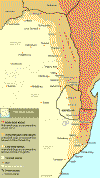- Malaria Treatment
- Malaria Information
- Prophylactic Measures To Prevent Malaria
- Malaria Can Be Prevented In The Following Ways
MALARIA MAP
[Click to enlarge]

Malaria in the greater Kruger Park area

People used to think that Malaria was caused by "bad air" rising from swamps - hence the name "malaria"
The information provided has been provided by certified authorities and will make your visit to Africa safe and rewarding one.
It is a well-known fact that malaria is one of the most serious and common tropical diseases in the world. However, there is no reason why this disease should deter you from coming to Africa if the necessary precautions are taken. Please note that if precautions are not taken and / or if the disease is not diagnosed and treated early, it could be potentially fatal.
Malaria is a word many people associate with game parks in Africa. However only the greater Kruger Park area is in a malaria risk zone, although even here the risk is usually low. Historically there have been incidences of malaria in other parks, but then there are recorded incidences of malaria from urban Europe and other non-risk areas.
Malaria prophylactics are thus recommended for visitors for Kruger.
The highest risk period is between December and April (end of the rainy season). A 24-hour malaria hotline is available on +27 (0)82 234 1800 to give detailed explanation on risk and advice on precautionary measures. Visitors wishing to take prophylactics should consult a knowledgeable medical practitioner or recognized travel clinic about recommended medication, as certain products cause nausea, hallucinations or other negative side effects with certain people.
Very often (particularly after periods of low rainfall) the malaria risk in Kruger is very low. Many people decide not to take prophylactics and rather try to avoid getting bitten. The most vulnerable times are between dusk and dawn. People are advised to stay indoors during these periods, or cover exposed skin with light clothing or insect repellents. The ankles are the most critical area. Burning anti-mosquito coils and ensuring netted screens are kept closed are other preventative measures.
While malaria prophylactics are recommended, no prophylactic is foolproof and any person developing flu-like symptoms 7 to 20 days (or even longer) after being in malaria areas should be tested immediately for malaria, until the symptoms clear or an alternative diagnosis is made. It is important to advise medical practitioners that you have been in a malaria area to avoid incorrect diagnosis.
The threat of malaria should not affect your decision to enjoy and experience the Kruger Park, but is just something one should be aware of and take precautions to be exposed to. [Back to top]
Prophylactic Measures To Prevent Malaria
Before traveling to remote areas, it may be wise to obtain a supply of emergency medication to take with you. This should only be used if it is not possible to consult a doctor. It is most important to note that no preventative measures are 100% safe. Should flu-like symptoms and signs like body pain, headache and fever develop 7 to 20 days or longer after visiting an endemic area, daily testing should be performed until you are better or another definite diagnosis is made. [Back to top]
Malaria Can Be Prevented In The Following Ways
The most important and most effective way of preventing malaria is firstly to prevent mosquito bites. The following preventative measures can be taken:
- Remain indoors from dusk to dawn if possible as mosquitoes usually feed in the early evenings and mornings.
- Cover your arms and legs towards evenings with light coloured clothing to cover exposed skin areas and especially the ankles. Wear long sleeved shirts, long trousers, socks and closed shoes.
- Apply insect repellents to exposed skin areas every 4-6 hours.
- Burn insecticide oils or electrically heated insecticide tablets in the bedroom at night.
- Spray knock-down insecticide for flying insects inside the bedroom in the early evening with windows / doors closed if there are no window screens.
- Screened mosquito proof windows and doors and Mosquito nets guard against Mosquito bites.
- Clothes and nets impregnated with Pyrethroid could be used.
Another way of preventing malaria is to take additional preventative drugs when visiting an endemic area, especially in the warm and rainy months from October to May.[Back to top]